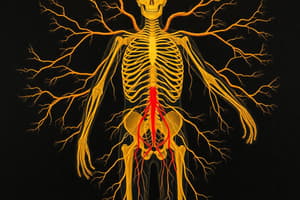Podcast
Questions and Answers
What does ANS stand for?
What does ANS stand for?
Autonomic Nervous System
Which of the following is NOT a function of the autonomic nervous system?
Which of the following is NOT a function of the autonomic nervous system?
- Regulating heart rate
- Regulating blood pressure
- Controlling voluntary muscle movement (correct)
- Secretion of bodily fluids
The sympathetic nervous system is responsible for the 'fight-or-flight' response.
The sympathetic nervous system is responsible for the 'fight-or-flight' response.
True (A)
The parasympathetic nervous system is responsible for the 'rest-and-digest' response.
The parasympathetic nervous system is responsible for the 'rest-and-digest' response.
Which neurotransmitter is primarily released at all preganglionic synapses in the autonomic nervous system?
Which neurotransmitter is primarily released at all preganglionic synapses in the autonomic nervous system?
Which of the following is a subtype of muscarinic receptors?
Which of the following is a subtype of muscarinic receptors?
What is the name of the enzyme that breaks down acetylcholine at the synapse?
What is the name of the enzyme that breaks down acetylcholine at the synapse?
Which type of adrenergic receptor is primarily responsible for vasoconstriction?
Which type of adrenergic receptor is primarily responsible for vasoconstriction?
What is the name of the precursor molecule in the synthesis of the catecholamines?
What is the name of the precursor molecule in the synthesis of the catecholamines?
Which of the following is NOT a catecholamine?
Which of the following is NOT a catecholamine?
Beta-2 adrenergic receptors are primarily located in the heart.
Beta-2 adrenergic receptors are primarily located in the heart.
Which of the following is a common effect of stimulatiing alpha-2 adrenergic receptors?
Which of the following is a common effect of stimulatiing alpha-2 adrenergic receptors?
Flashcards
What is the autonomic nervous system?
What is the autonomic nervous system?
The autonomic nervous system (ANS) is a crucial part of the peripheral nervous system, responsible for regulating involuntary bodily functions.
What are some functions of the ANS?
What are some functions of the ANS?
The ANS manages vital functions like blood pressure, heart rate, breathing, temperature, digestion, and pupil dilation.
What is the role of the sympathetic nervous system in the fight-or-flight response?
What is the role of the sympathetic nervous system in the fight-or-flight response?
The fight-or-flight response, triggered by stress, is a key role of the sympathetic nervous system. It prepares the body for action by increasing heart rate, blood pressure, and alertness.
How does the parasympathetic system relate to the sympathetic system?
How does the parasympathetic system relate to the sympathetic system?
Signup and view all the flashcards
What are the main divisions of the ANS?
What are the main divisions of the ANS?
Signup and view all the flashcards
What is the sympathetic nervous system known for?
What is the sympathetic nervous system known for?
Signup and view all the flashcards
What is the parasympathetic nervous system known for?
What is the parasympathetic nervous system known for?
Signup and view all the flashcards
What is the enteric nervous system?
What is the enteric nervous system?
Signup and view all the flashcards
What is the primary neurotransmitter of the parasympathetic nervous system?
What is the primary neurotransmitter of the parasympathetic nervous system?
Signup and view all the flashcards
Where else does acetylcholine play a role in the ANS?
Where else does acetylcholine play a role in the ANS?
Signup and view all the flashcards
What is the main neurotransmitter in the postganglionic sympathetic nervous system?
What is the main neurotransmitter in the postganglionic sympathetic nervous system?
Signup and view all the flashcards
What enzyme is involved in producing acetylcholine?
What enzyme is involved in producing acetylcholine?
Signup and view all the flashcards
What breaks down acetylcholine?
What breaks down acetylcholine?
Signup and view all the flashcards
What are muscarinic receptors?
What are muscarinic receptors?
Signup and view all the flashcards
How many subtypes of muscarinic receptors are there?
How many subtypes of muscarinic receptors are there?
Signup and view all the flashcards
What are nicotinic receptors?
What are nicotinic receptors?
Signup and view all the flashcards
How many subtypes of nicotinic receptors are there?
How many subtypes of nicotinic receptors are there?
Signup and view all the flashcards
What hormones are released by the adrenal medulla?
What hormones are released by the adrenal medulla?
Signup and view all the flashcards
What is the process of catecholamine synthesis?
What is the process of catecholamine synthesis?
Signup and view all the flashcards
What are adrenergic receptors?
What are adrenergic receptors?
Signup and view all the flashcards
What are alpha adrenergic receptors?
What are alpha adrenergic receptors?
Signup and view all the flashcards
What are beta adrenergic receptors?
What are beta adrenergic receptors?
Signup and view all the flashcards
What are the roles of β3, β4, and β5 receptors?
What are the roles of β3, β4, and β5 receptors?
Signup and view all the flashcards
Why are adrenergic receptors important?
Why are adrenergic receptors important?
Signup and view all the flashcards
Study Notes
Autonomic Nervous System
- The autonomic nervous system (ANS) is part of the peripheral nervous system
- It regulates involuntary physiological processes
- The ANS has three distinct divisions: sympathetic, parasympathetic, and enteric
Objectives of the Autonomic Nervous System
- Learning the organization and functions of the ANS
- Understanding the synthesis of autonomic neurotransmitters
- Knowing the receptor types in the ANS and their distribution
Organization of the ANS
- The ANS is composed of two neurons (preganglionic and postganglionic)
- The preganglionic neuron is connected to a ganglion
- The postganglionic neuron is connected to the target organ or tissue.
- The CNS has two divisions: craniosacral and thoracolumbar
- The craniosacral division is part of the parasympathetic nervous system
- The thoracolumbar division is part of the sympathetic nervous system
- Autonomic pathways regulate various organs, such as the heart, smooth muscles, and glands and blood vessels and skeletal muscles.
Sympathetic Nervous System
- The sympathetic nervous system (SNS) is part of the ANS
- It controls the "fight-or-flight" response
- Its preganglionic neurons are short and the postganglionic neurons are long.
- It uses norepinephrine (NE) often in the postganglionic neurons
- The preganglionic neurotransmitter is acetylcholine (ACh).
Parasympathetic Nervous System
- The parasympathetic nervous system (PNS) is part of the ANS
- It controls the "rest-and-digest" response
- Its preganglionic neurons are long and postganglionic neurons are short
- It uses acetylcholine (ACh) at both preganglionic and postganglionic neurons.
Neurotransmitters
-
Acetylcholine (ACh) is a neurotransmitter used by both the parasympathetic and sympathetic nervous systems.
-
Norepinephrine (NE) is a neurotransmitter used by the sympathetic nervous system.
-
Epinephrine (EPI) is another neurotransmitter used by the sympathetic nervous system; it's also called adrenaline
Sites of Release of Acetylcholine
- Acetylcholine (ACh) is released at all preganglionic nerve endings, both sympathetic and parasympathetic.
- ACh is released at preganglionic sympathetic fibers connecting to the adrenal medulla
- ACh is released at postganglionic parasympathetic ending
- ACh is released at some postganglionic sympathetic nerve endings
- ACh is released at somatic motor nerve endings
- ACh is released at some CNS synapses
Synthesis of Catecholamines
- Tyrosine is converted into L-DOPA and then to dopamine.
- Dopamine is then further converted to norepinephrine
- Norepinephrine further converted to epinephrine
Adrenergic Receptors
- Adrenergic receptors bind to norepinephrine (NE) and epinephrine (EPI)
- There are subtypes α and β
- α receptors are mainly excitatory
- β receptors are mainly inhibitory
Distribution of Adrenergic Receptors
- Different types of adrenergic receptors are located in specific tissues, like heart and blood vessels
Studying That Suits You
Use AI to generate personalized quizzes and flashcards to suit your learning preferences.
Related Documents
Description
Explore the autonomic nervous system (ANS) and its critical role in regulating involuntary physiological processes. This quiz covers the organization, functions, and neurotransmitter synthesis within the ANS, as well as the distinct divisions of sympathetic, parasympathetic, and enteric systems. Test your understanding of the various receptor types and their distribution.




